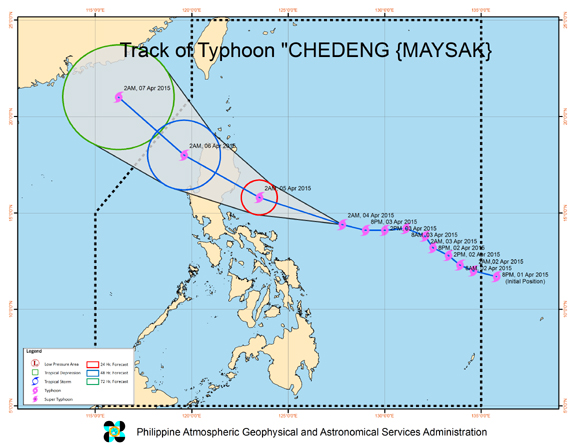Local government units in areas that are expected to be hit by typhoon Chedeng (international name Maysak) in the Philippines are gearing up for the onslaught of the storm, which is expected to make landfall in Casiguran, Aurora.
The Philippine Atmospheric, Geophysical and Astronomical Services Administration (Pagasa) said the location of the typhoon’s center was 625 kilometers East Southeast of Casiguran, Aurora as of 5 a.m. Saturday.
The typhoon still packs maximum sustained winds of 155 kilometers per hour (kph) near the center and gustiness of up to 160 kph.
It was forecast to move West Northwest at 19 kph.
Public storm warning signal Number 2 was raised in Catanduanes, which should expect heavy stormy weather to intense rains, Pagasa said.
“Residents along coasta areas are alerted against possible storm surge of up to 2 meters,” Pagasa said in its bulletin.
Public storm signal number 1 was also raised in Camarines Sur, Camarines Norte, Quezon Incl Polillo Island, Rizal, Bulacan, Pampanga, Tarlac, Nueva Ecija, Pangasinan, La Union, Ilocos Norte, Ilocos Sur, Abra, Apayao, Cagayan, Benguet, Kalinga, Aurora, Quirino, Nueva Viscaya, Ifugao, Isabela and Mountain Province.
Meanwhile, the Department of Social Welfare and Development (DSWD) appeals to the public to continue monitoring and preparing for Typhoon Chedeng despite weather reports indicating that it has weakened.
“We ask the public, especially, those in areas along the typhoon path to continue preparing. Even if it is not a super typhoon, Chedeng is still expected to cause damage due to heavy rains and wind,” DSWD Secretary Corazon Juliano-Soliman said.
In a press briefing at the National Disaster Risk Reduction and Management Council (NDRRMC) Friday morning, it was reported that Typhoon Chedeng can cause massive floods and damages to the agriculture and infrastructure sectors.
“It is highly advisable that the people act with extreme caution, especially in areas that are expected to be hardest-hit like the provinces of Isabela and Aurora,” Sec. Soliman added.
DSWD disaster teams along the typhoon path remain on 24/7 duty to assist local government units (LGUs) implement pre-emptive evacuation plans.
The prepositioning of goods to cities and municipalities continues, especially in coastal and hard-to-reach areas. This is part of the strengthened government initiatives for any calamity or disaster that may hit the country. – BusinessNewsAsia.com
